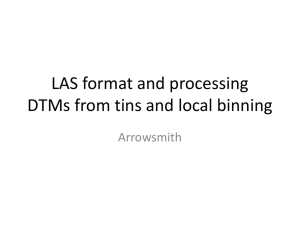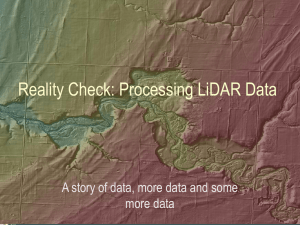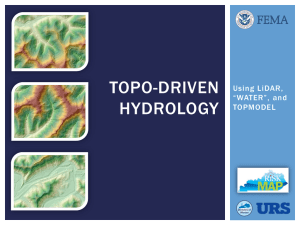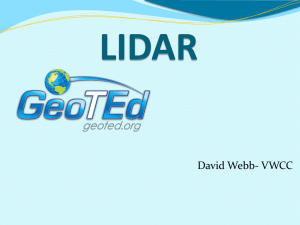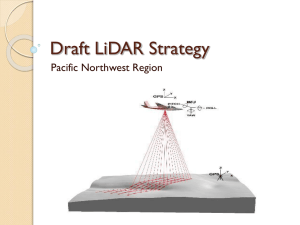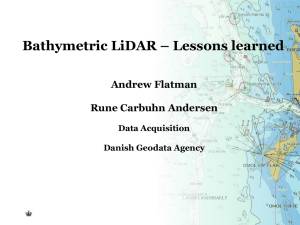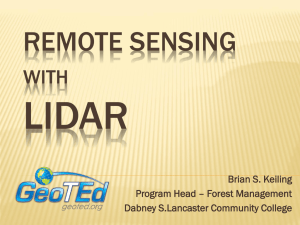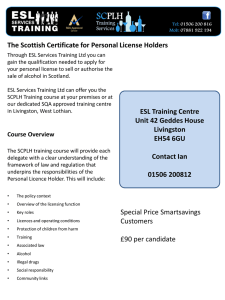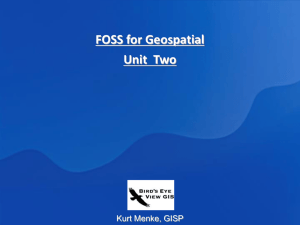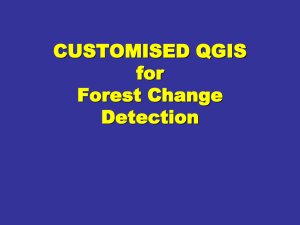Utilizing Open Source Software to Derive Products
advertisement
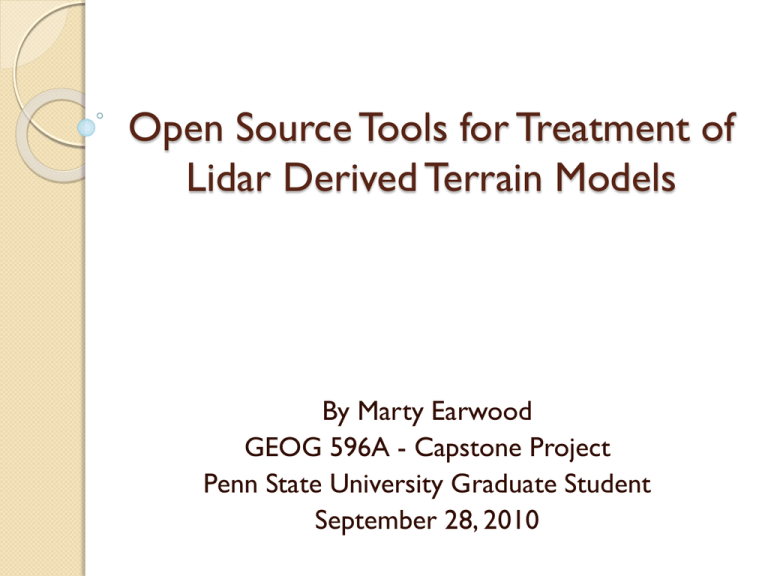
Open Source Tools for Treatment of Lidar Derived Terrain Models By Marty Earwood GEOG 596A - Capstone Project Penn State University Graduate Student September 28, 2010 Overview • • • • • Purpose and Objectives Define Open Source Software (OSS) Outline Product Specifications - USGS Identify Open Source Tools Summary and Conclusion Purpose and Objectives • Purpose: • To define what is meant by the term open source software and research open source GIS packages that can produce hydro-flattened Digital Elevation Models (DEM) and breaklines to USGS specifications. • Objective: • To identify specific OSS GIS packages that can be used or combined to meet specifications What is Open Source Software? • Software that complies with the following 10 criteria: 1. Free Redistribution • Non-restrictive software license • No royalty or other fees are required for sale of aggregate software 2. Source Code • Source code must be included with the distribution • If a portion of the source is not distributed, there must be well publicized means of obtaining the code at a reasonable reproduction cost Open Source Software • Criteria continued: 3. Derived works • • License must allow modifications and derived works These works must be allowed to be distributed under the same term 4. Integrity of the author’s source code • • • License may restrict redistribution in modified form only if the license allows for the distribution of “patch files” at build time. License must explicitly permit the distribution of software built from modified source code License may require a different name or version number from the originating software Open Source Software • Criteria continued: 5. No discrimination against persons or groups 6. No discrimination against fields of endeavor 7. Distribution of license • Rights attached to the software must transfer to all redistributed copies without a requirement for additional licensing 8. License must not be specific to a product • • The rights of the software must not be dependent upon a particular software distribution If the program is extracted from that distribution, the rights of the original distribution are transferred Open Source Software • Criteria continued: 9. License must not restrict other software • Example – the license must not require that all other programs distributed on the same medium to be open source software 10. License must be technology-neutral • License may not restrict any individual technology or style of interface USGS Hydro-Flattened Digital Elevation Model Specification • • Requirements are outlined in Section III of the USGS NGP Lidar Guideline and Base Specification Hydrology Feature Requirements: • Inland Ponds and Lakes >= 2 acres should be flat (every bank vertex has the same elevation) and the surface edge should be at or below the immediate terrain USGS Hydro-Flattened DEM Specification - continued • Inland Streams and Rivers • 100’ nominal width • Flat and level bank-to-bank with vertices perpendicular to the apparent flow centerline (flow should follow the gradient of the immediate terrain) • Water edge should be below immediate terrain • Should continue through elevated bridges, but break where at culvert locations • Non-Tidal Boundaries • Represented as a single edge or edges when collection does not include the opposing shore USGS Hydro-Flattened DEM Specification - continued • Tidal Boundaries • Discontinuities along the shoreline over the course of a collection are considered normal and should be retained • Single-line stream breaklines • Not required unless cooperating partners require collection and integration. • Refer to specification for guidelines USGS Hydro-Flattened DEM Specification - continued • Reclassification of Bare-earth Lidar • Points in close proximity (distance approximately equal to the nominal point spacing) to breaklines should be excluded from DEM generation • Should be retained, reclassified as “Ignored Ground” (class = 10) and delivered as part of the lidar point dataset • Delivered data should be sufficient to recreate the delivered DEMs using lidar points and breaklines without further editing Hydro-Flattened DEM Example Lidar only Hydro-flattened Lidar Deliverables • • • Metadata Raw point cloud Classified point cloud • Edited LAS file that was used to produce the hydro-flattened DEM • Bare Earth DEM • 3 meter Cell size, 32-bit floating point raster (ERDAS .IMG preferred) • polylineZ and polygonZ breaklines shapefiles Open Source Software/Tools • Tools were evaluated for: • Ability to read/write native LAS format • Geoprocessing/data manipulation Capabilities (i.e. – interpolation, raster analysis) • Vector digitizing capabilities (2D) • Scripting or programmability (Access to 3D geometries) • Tools researched were: • lasTools, GRASS, Quantum GIS and gvSIG LASTools Suite of 12 command line tools that are able to read from and write to LAS formats • Key tools • • • • • • • • Parse and write the LAS header to text Convert from LAS to ASCII text Convert from shapefile to LAS Combine LAS files Create TINs/DEMs Thinning algorithm Not a GIS, but could be used in conjunction with one to help meet specifications GRASS v6.4 • • • • Geographical Resources Analysis Support System Originally developed by the U.S. Army Corps of Engineers Construction Engineering Research Laboratories Is raster and vector GIS combined with image processing and data visualization Core has 350 modules for management, processing, analysis, and visualization of georeferenced data. GRASS – continued • • • Modules are accessible from a Command Line Interface (CLI) or through the wxPython GUI interface GRASS 6 is written in ANSI C programming language with a few UNIX and PERL scripts The CLI provides scripting ability from various languages: PERL, Python, Ruby, and Tcl/Tk GRASS Evaluation • • • • • No tools/modules provided for lidar LAS format – can convert from xyz text to vector or raster for analysis Current version does not have tools for digitizing features Well developed set of geoprocessing tools for existing data manipulation or raster creation Scripting ability provides access to streamline manual processes Requires tools for vector creation and manipulation of LAS files to be utilized towards meeting specifications Quantum GIS (QGIS) v1.5 Started in 2002 to build a GIS data viewer on Linux • Best known for it’s support of large amount of data types (both vector and raster through GDAL and OGR libraries) • Ability to edit vector shapes and attribute tables through a GUI • Provides tools that allow for heads up digitizing • QGIS – continued • • Written in C++ Provided Command Line Interface gives access to scripting ability through Python QGIS Evaluation • • • • No tools/modules provided for lidar LAS format – can convert from xyz text to vector or raster for analysis Vector support is limited to 2D extraction Access to GRASS modules provided through an established Plugin Could be customized with Python scripts or through GUI gvSIG v1.1.2 with DielmoLidarExtension v 2 Began in 2004 within a project to migrate the information technology systems of the Regional Ministry of Infrastructure and Transport of Valencia, Spain to free software • Support for common data formats • Ability to display local and remote data in the same view • Ability to edit vector data and attributes through a GUI • gvSIG - continued • • • Geoprocessing tools provided within an extension called Sextante Written in Java Best known for being designed to be easily extendable and enabling tailor-made solutions gvSIG DielmoLidarExtension Evaluation • • Vector support limited to 2D extraction DielmoLidarExtension provides tools for lidar within gvSIG • Ability to read/write/edit native LAS • Extension has built-in QA/QC tools for lidar • Flight lines • Control points • • Translations to English not fully complete Customizable using Java programming Summary • • • Defined Open Source Software Outlined Product Specifications and deliverables for USGS Identified Open Source Tools • lasTools • GRASS • gvSIG with DielmoLidarExtension Conclusion • • The package that provides the tools required for meeting the specifications outlined by the USGS is gvSIG. Customized tools within gvSIG could potentially be developed to: • Provide access to the Z value of the shapefiles in order to be populated • Streamline geoprocessing tools into a GUI • lasTools, QGIS and GRASS could be used in conjunction to meet specifications. Conclusion – continued Creation of a custom breakline tool is vital to meeting the specifications for shapefiles • Currently reviewing the object models of gvSIG and QGIS to find out which one can provide access to populate the z-value of the shapefile geometry • Decision of which program to code for and in what language needs to be made • Milestones need to be established(i.e. – providing the capability to digitize a lake with constant elevations) • Questions?
